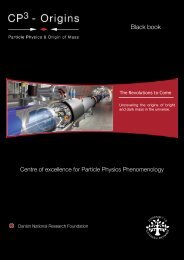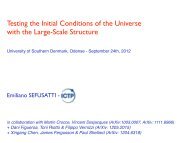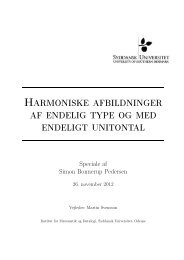Discovering Technicolor: Final Report for LHC School ... - CP3-Origins
Discovering Technicolor: Final Report for LHC School ... - CP3-Origins
Discovering Technicolor: Final Report for LHC School ... - CP3-Origins
Create successful ePaper yourself
Turn your PDF publications into a flip-book with our unique Google optimized e-Paper software.
6<br />
At this point, the theory contains only fields at the fundamental level (i.e., partonic<br />
fields and no composites nor interactions of composite fields).<br />
However, it is possible<br />
to construct an effective low-energy Lagrangian <strong>for</strong> Minimal Walking <strong>Technicolor</strong> with<br />
technimesons that has the following <strong>for</strong>m:<br />
L = 1 2 Tr[D µMD µ M † ] − V(M) + L ET C + L vector , (7)<br />
V(M) = − m2 M<br />
2 Tr[MM† ] + λ 4 (Tr[MM† ]) 2 + λ ′ Tr[MM † MM † ]<br />
− 2λ ′′ [det M + det M † ], (8)<br />
L ET C = m2 ET C<br />
Tr[MBM † B + MM † ], (9)<br />
4<br />
L vector = − 1 2 Tr[ ˜W µν ˜W µν ] − 1 4 Tr[B µνB µν ] − 1 2 Tr[F µνF µν ] + m 2 Tr[C µ C µ ]. (10)<br />
Fields contained in the above equations are composed from two techniquarks. The matrix<br />
M contains the scalar Higgs field and its pseudoscalar partner as well as nine pseudoscalar<br />
Goldstone bosons and their scalar partners; it trans<strong>for</strong>ms under SU(4) according<br />
to M → uMu T [and u ∈ SU(4)]. Note that the electroweak symmetry breaking reduces<br />
the original gauge group SU(4) to its maximal diagonal subgroup SO(4) and thus one<br />
obtains nine pseudoscalar Goldstone bosons. Three of the Goldstone bosons become longitudinal<br />
degrees of freedom of the gauge bosons W ± and Z 0 ; the mass of the remaining<br />
six Goldstone bosons is generated by the Extended <strong>Technicolor</strong> (ETC) term L ET C , Eq.<br />
(9) with B = diag(1 2 , −1 2 ). The axial anomaly is described by the term [det M +det M † ];<br />
it also generates the mass of the chiral partner of the Higgs state. Let us also note that<br />
Eq. (8) yields m 2 H = 2m2 M .<br />
Furthermore, vector bosons are described by the four-dimensional traceless Hermitian<br />
matrix A µ = A µa T a where T a are the generators of SU(4) and A µ → uA µ u † under<br />
group trans<strong>for</strong>mations; then the field strength tensor F µν in Eq. (10) is F µν =<br />
∂ µ A ν − ∂ ν A µ − i˜g[A µ , A ν ] and the tensors ˜W µν and B µν represent the usual field strength<br />
tensors of the electroweak gauge group (but the ˜W bosons do not correspond to the physical<br />
W ± states - the physical states are originated in the mixing of the ˜W with the composite<br />
vectors from the Lagrangian). Also, C µ = A µ − (g/˜g)G µ with gG µ = gWµ a L a + g ′ B µ Y<br />
where L a and Y generate the left-handed and hypercharge trans<strong>for</strong>mations.








